Coupling and Coordination Analysis of Digital Economy and Green Agricultural Development: Evidence from Major Grain Producing Areas in China
Abstract
1. Introduction
2. Literature Review and Mechanism Analysis
2.1. The Impact of Digital Economy on Green Agricultural Development
2.2. The Impact of Green Agricultural Development on the Digital Economy
2.3. The Interaction Mechanism of the Two and the Method of Studying the Interaction
3. Evaluation System Establishment, Research Scope, and Data Sources
3.1. Evaluation System Establishment
3.1.1. Digital Economy (DE)
3.1.2. Agricultural Green Development (AGD)
3.1.3. Abbreviations of Key Variables
3.2. Research Scope and Data Sources
4. Methodology and Calculation Process
4.1. EW-TOPSIS
- (1)
- Data standardization: The first step requires dimensionless processing of the original data to make the different indicators comparable. In this study, the “Extreme Value” method was used to process the positive indicators, as shown in (1), and the processing method for the negative indicators is shown in (2), where Xab represents the a-th variable in the b region of the index system and xab is the original value:
- (2)
- Calculate the coefficient of variation, entropy, and weight: Entropy E with coefficient of variation V can more accurately reflect the degree of dispersion among indicator data. Therefore, the second step needed to calculate the coefficient of variation (such as Formula (3)), the entropy value of each index (such as Formula (4)), and the final weight (such as Formula (5)). The final weight W obtained represents the importance degree of the index in the comprehensive evaluation system, which prepares for the following TOPSIS calculation.
- (3)
- TOPSIS is actually based on the original data matrix after standardization, and the cosine method is used to find out the optimal and worst schemes (represented by vectors) among all the schemes. Then, the distance (Euclidean distance) between each evaluation object and the optimal scheme and the worst scheme is calculated, respectively, and the ranking is established according to the distance, which is used as the basis for the evaluation of superiority and inferiority. So, for the calculation of TOPSIS, the positive and negative ideal solutions should be specified first (6), and then the Euclidean distance should be calculated (7).
- (4)
- Calculate the final score D of the final index and variable (0 ≤ D ≤ 1)
4.2. Coupling Coordination Development (CCD)
- (1)
- Calculate the coupling degree C of the two systems. The first step of the coupling coordination degree model was to evaluate the coupling size of the data with the concept of “coupling”, with a larger value indicating a stronger interaction strength between the systems. In Formula (9), D1 and D2 are the EW-TOPSIS scores of the digital economy and the agricultural green development system, respectively.
- (2)
- Calculate the coupling coordination degree (CCD) of the two systems: The second step was to calculate the coupling coordination degree between the DE and AGD. λ and γ are the coefficients, considering that the two subsystems of the digital economy and agricultural green development are of the same importance, so set λ = γ = 0.5
4.3. Study on Influencing Factors (Gray Correlation Degree)
- (1)
- Determine the reference sequence and comparison sequence: In order to calculate the grey correlation degree between the two subsystems of DE and AGD, the index or variable of AGD was set as the comparison sequence Sx, and the index or variable of the DE was set as the reference sequence Sy.
- (2)
- Calculate the correlation coefficient of the two sequences ϛyx (t), where ρ is defined as 0.5
- (3)
- Calculate the gray correlation degree of the two sequences.
- (4)
- Organize GCD into matrix form.
5. Results and Discussion
5.1. Development Level of the Digital Economy
5.1.1. The Level of Development Varies over Time
5.1.2. Spatial Distribution of Development Levels of the Digital Economy
5.2. Development Level of Agricultural Green Development
5.2.1. The Level of Development Varies over Time
5.2.2. Spatial Distribution of the Development Level of Agricultural Green Development
5.3. Comparison of the Two Systems
5.4. Development Level of CCD
5.4.1. Change in CCD over Time
5.4.2. Spatial Evolution of CCD
5.5. Gray Correlation Degree (GCD)
5.5.1. Influencing Factors of the Digital Economy on Agricultural Green Development
5.5.2. Influencing Factors of Agricultural Green Development on the Digital Economy
5.6. Discussion
6. Conclusions
- The level of digital economy and agricultural green development in China’s main grain-producing areas generally displayed an upward trend over the decade from 2012 to 2021. The number of provinces lagging behind in the development of the digital economy was greater than the number of provinces lagging behind in the development of the agricultural industry, so the overall development of the digital economy relatively lagged behind. The development level of both subsystems showed a clear gap between different regions, and the northeast region should address the shortcomings in its digital economic development as soon as possible, while the economically developed coastal regions should work on their sustainable agricultural production methods.
- The degree of coupling and coordination between the digital economy and agricultural green development systems in China’s major grain-producing regions was generally on an upward trend in the decade from 2012 to 2021, with all provinces eventually having a “coordinated development” rating. Different regions displayed different rates of increase in CCD, and the gap between the first- and last-ranked CCD scores was very obvious. Therefore, policymakers should work on promoting synergistic development among different regions so that regions that have already achieved a high level of coordination can help regions with a lower level of coordination through “technological spillovers” and so on, in order to achieve common prosperity.
- In 2012, the digital economy influenced the greening of agriculture mainly through its outputs. The green development of agriculture mainly affected the development of the digital economy through the application of advanced agricultural technology and the process of upgrading the agricultural industry. This shows that, in 2012, the output results of the existing inputs in the digital economy had an obvious positive effect on the green development of agriculture, and the green development of agriculture was positively affected by the “technological spillover” effect of the digital economy.
- In 2021, the main influencing factor of the digital economy system on the agricultural green development system became the “Input” indicator of the digital economy system. The main influence of the agricultural green development system on the digital economy system became the indicator “Resource utilization and environmental protection” in the agricultural green development system. This proves that, after 10 years of development, there is still a need for more targeted investment in science and technology applicable to agriculture in order to meet the demand for new science and technology for the greening of agriculture. As for the green development of agriculture, it is necessary to pay more attention to the effectiveness of environmental protection and the rationality and scientificity of resource utilization in order to make the digital economy in China’s main grain-producing areas and the green development of agriculture more coordinated.
Author Contributions
Funding
Institutional Review Board Statement
Informed Consent Statement
Data Availability Statement
Conflicts of Interest
References
- Dhillon, B.S.; Kataria, P.; Dhillon, P.K. National food security vis-à-vis sustainability of agriculture in high crop productivity regions. Curr. Sci. 2010, 98, 33–36. [Google Scholar]
- Rosenzweig, C.; Mbow, C.; Barioni, L.G.; Benton, T.G.; Herrero, M.; Krishnapillai, M.; Liwenga, E.T.; Pradhan, P.; Rivera-Ferre, M.G.; Sapkota, T.; et al. Climate change responses benefit from a global food system approach. Nat. Food 2020, 1, 94–97. [Google Scholar] [CrossRef] [PubMed]
- Gebresamuel, G.; Opazo-Salazar, D.; Corral-Nunez, G.; van Beek, C.; Elias, E.; Okolo, C.C. Nutrient Balance of Farming Systems in Tigray, Northern Ethiopia. J. Soil. Sci. Plant Nutr. 2021, 21, 315–328. [Google Scholar] [CrossRef]
- Liu, Y.; Sun, D.; Wang, H.; Wang, X.; Yu, G.; Zhao, X. An evaluation of China’s agricultural green production: 1978–2017. J. Clean. Prod. 2020, 243, 118483. [Google Scholar] [CrossRef]
- Adejumo, O.O. Environmental quality vs. economic growth in a developing economy: Complements or conflicts. Environ. Sci. Pollut. Res. 2020, 27, 6163–6179. [Google Scholar] [CrossRef] [PubMed]
- Ali, E.B.; Anufriev, V.P.; Amfo, B. Green economy implementation in Ghana as a road map for a sustainable development drive:are view. Sci. Afr. 2021, 12, e00756. [Google Scholar]
- Marxist. Capital; People’s Publishing House: Beijing, China, 2004; Volume 3, p. 919. (In Chinese) [Google Scholar]
- Zhang, Q.; Qu, Y.; Zhan, L. Great transition and new pattern: Agriculture and rural area green development and its coordinated relationship with economic growth in China. J. Environ. Manag. 2023, 344, 118563. [Google Scholar] [CrossRef] [PubMed]
- Chen, Z.; Sarkar, A.; Rahman, A.; Li, X.J.; Xia, X.L. Exploring the drivers of green agricultural development (GAD) in China: A spatial association network structure approach. Land Use Policy 2021, 112, 105827. [Google Scholar] [CrossRef]
- Wang, J.; Yang, G.; Zhou, C. Does internet use promote agricultural green development? Evidence from China. Int. Rev. Econ. Financ. 2024, 93, 98–111. [Google Scholar] [CrossRef]
- Järnberg, L.; Enfors Kautsky, E.; Dagerskog, L.; Olsson, P. Green niche actors navigating an opaque opportunity context: Prospects for a sustainable transformation of Ethiopian agriculture. Land Use Policy 2018, 71, 409–421. [Google Scholar] [CrossRef]
- Jiang, H.; Elahi, E.; Gao, M.; Huang, Y.; Liu, X. Digital economyto encourage sustainable consumption and reduce carbon emissions. J. Clean. Prod. 2024, 443, 140867. [Google Scholar] [CrossRef]
- Brynjolfsson, E.; Collis, A.; Diewert, W.E.; Eggers, F.; Fox, K.J. Accounting for the Value of New and Free Goods in the Digital Economy; NBER Working Papers; No. 25695; National Bureau of Economic Research: Cambridge, MA, USA, 2019. [Google Scholar]
- Feng, G.; Shang-guang, Y.; Yi, R. Digital economy, Green technology innovatio and carbon emission: Empirical evidence from urban level in China. J. Shanxi Normal Univ. (Philos. Soc. Sci. Ed.) 2022, 51, 45–60. [Google Scholar]
- OECD. Measuring the Digital Economy: A New Perspective; OECD Publishing: Paris, France, 2014. [Google Scholar]
- Cong, L.W.; Xie, D.; Zhang, L. Knowledge accumulation, privacy, and growth in a data economy. Manag. Sci. 2021, 67, 6480–6492. [Google Scholar] [CrossRef]
- Jing, W.; Sun, B. Digital economy promotes sustainable economic development: A theoretical analysis framework. J. Econom. 2019, 242, 66–73. [Google Scholar]
- Ma, X.; Feng, X.; Fu, D.; Tong, J.; Ji, M. How does the digital economy impact sustainable development?—An empirical study from China. J. Clean. Prod. 2024, 434, 140079. [Google Scholar] [CrossRef]
- Sparrow, R.; Howard, M. Robots in agriculture: Prospects, impacts, ethics, and policy. Precis. Agric. 2021, 22, 818–833. [Google Scholar] [CrossRef]
- Harou, A.P.; Madajewicz, M.; Michelson, H.; Palm, C.A.; Amuri, N.; Magomba, C.; Semoka, J.M.; Tschirhart, K.; Weil, R. The joint effects of information and financing constraints on technology adoption: Evidence from a field experiment in rural Tanzania. J. Dev. Econ. 2022, 155, 102707. [Google Scholar] [CrossRef]
- Yang, L.; Lin, Y.; Zhu, J.; Yang, K. Dynamic coupling coordination and spatial–temporal analysis of digital economy and carbon environment governance from provinces in China. Ecol. Indic. 2023, 156, 111091. [Google Scholar] [CrossRef]
- Wang, Z. On the Systematization and Complexity of Society and Marx’s Idea of a Community of Individuals. J. Syst. Sci. 2020, 28, 7–11. (In Chinese) [Google Scholar]
- Deng, X.; Xu, D.D.; Zeng, M.; Qi, Y.B. Does Internet use help reduce rural cropland abandonment? Evidence from China. Land Use Policy 2019, 89, 104243. [Google Scholar] [CrossRef]
- Ding, L. Digital economy, industrial agglomeration and regional economic resilience. J. Mod. Manag. Sci. 2023, 340, 132–140. [Google Scholar]
- Wang, J.; Song, L.; Zhang, X. Digital Economy, industrial agglomeration and innovation efficiency of regional e-commerce. J. Explor. Econ. Issues 2021, 470, 156–165. [Google Scholar]
- Li, X.K.; Guo, H.D.; Jin, S.Q.; Ma, W.L.; Zeng, Y.W. Do farmers gain internet dividends from E-commerce adoption? Evidence from China. Food Policy 2021, 101, 102024. [Google Scholar] [CrossRef]
- Ji, X.; Xu, J.; Zhang, H. Environmental effects of rural E-commerce: A case study of chemical fertilizer reduction in China. J. Environ. Manag. 2023, 326, 116713. [Google Scholar] [CrossRef] [PubMed]
- Cafer, A.M.; Rikoon, J.S. Adoption of new technologies by smallholder farmers: The contributions of extension, research institutes, cooperatives, and access to cash for improving tef production in Ethiopia. Agric. Hum. Values 2018, 35, 685–699. [Google Scholar] [CrossRef]
- Sieber, S.; Graef, F.; Amjath-Babu, T.S.; Mutabazi, K.D.; Tumbo, S.D.; Faße, A.; Gomezy Paloma, S.; Rybak, C.; Lana, M.A.; Ndah, H.T.; et al. Trans-SEC’s food security research in Tanzania: From constraints to adoption for out-andupscaling of agricultural innovations. Food Secur. 2018, 10, 775–783. [Google Scholar] [CrossRef]
- Zhao, P.P.; Zhang, W.; Cai, W.C.; Liu, T.J. The impact of digital finance use on sustainable agricultural practices adoption among smallholder farmers: An evidence from rural China. Environ. Sci. Pollut. Res. 2022, 29, 39281–39294. [Google Scholar] [CrossRef] [PubMed]
- Zha, J.; Dai, J.; Ma, S.; Chen, Y.; Wang, X. How to decouple tourism growth from carbon emissions? A case study of Chengdu, China. Tour. Manag. Perspect. 2021, 39, 100849. [Google Scholar] [CrossRef]
- Khan, Z.; Ali, S.; Dong, K.; Li, R.Y.M. How does fiscal decentralization affect CO2 emissions? The roles of institutions and human capital. Energy Econ. 2021, 94, 105060. [Google Scholar] [CrossRef]
- Khan, M.K.; Babar, S.F.; Oryani, B.; Dagar, V.; Rehman, A.; Zakari, A.; Khan, M.O. Role of financial development, environmental-related technologies, research and development, energy intensity, natural resource depletion, and temperature in sustainable environment in Canada. Environ. Sci. Pollut. Res. 2022, 29, 622–638. [Google Scholar] [CrossRef] [PubMed]
- Lin, S.Y. Bringing resource management back into the environmental governance agenda: Eco-state restructuring in China. Environ. Dev. Sustain. 2021, 23, 12272–12301. [Google Scholar] [CrossRef]
- Downey, L.; Dubois, S.; Hawkins, B.; Walker, M. Environmental Inequality in Metropolitan America. Organ. Environ. 2008, 21, 270–294. [Google Scholar] [CrossRef] [PubMed]
- Rehdanz, K.; Maddison, D. Local environmental quality and life-satisfaction in Germany. Ecol. Econ. 2008, 64, 787–797. [Google Scholar] [CrossRef]
- Marques, S.; Lima, M.L. Living in grey areas: Industrial activity and psychological health. J. Environ. Psychol. 2011, 31, 314–322. [Google Scholar] [CrossRef]
- Chang, C.F.; Wang, P.; Liu, J.T. Knowledge spillovers, human capital and productivity. J. Macroecon. 2016, 47, 14–232. [Google Scholar] [CrossRef]
- Chen, S.; Oliva, P.; Zhang, P. The effect of air pollution on migration: Evidence from China. J. Dev. Econ. 2022, 156, 102833. [Google Scholar] [CrossRef]
- Wang, L.; Dai, Y.; Xie, X.; Kong, D. Air Pollution and Firm Employee Mobility. Edit. Off. J. Financ. Econ. 2020, 46, 93–106. [Google Scholar]
- Han, X.; Wang, Y.; Yu, W.; Xia, X. Coupling and coordination between green finance and agricultural green development: Evidence from China. Financ. Res. Lett. 2023, 58, 104221. [Google Scholar] [CrossRef]
- Liberalesso, T.; Cruz, C.O.; Silva, C.M.; Manso, M. Green infrastructure and public policies: An international review of green roofs and green walls incentives. Land Use Policy 2020, 96, 104693. [Google Scholar] [CrossRef]
- Koohafkan, P.; Altieri, M.A.; Gimenez, E.H. Green agriculture: Foundations for biodiverse, resilient and productive agricultural systems. Int. J. Agric. Sustain. 2012, 10, 61–75. [Google Scholar] [CrossRef]
- Liu, L.; Gu, T.T.; Wang, H. The Coupling Coordination between Digital Economy and Industrial Green High-Quality Development: Spatio-Temporal Characteristics, Differences and Convergence. Sustainability 2022, 14, 16260. [Google Scholar] [CrossRef]
- Wang, R.; Cheng, J.H.; Zhu, Y.L.; Lu, P.X. Evaluation on the coupling coordination of resources and environment carrying capacity in Chinese mining economic zones. Resour. Policy 2017, 53, 20–25. [Google Scholar] [CrossRef]
- Ye, S.; Ge, Y.J.; Xu, S.Y.; Ma, X.F. Measurement and Prediction of Coupling Coordination Level of Economic Development, Social Stability and Ecological Environment in Qinghai-Thoughts on Sustainable Societal Safety. Sustainability 2022, 14, 10515. [Google Scholar] [CrossRef]
- Dong, F.; Hu, M.; Gao, Y.; Liu, Y.; Zhu, J.; Pan, Y. How does digital economy affect carbon emissions? Evidence from global 60 countries. Sci. Total Environ. 2022, 852, 158401. [Google Scholar] [CrossRef]
- Zoppelletto, A.; Orlandi, L.B. Cultural and digital collaboration infrastructures as sustainability enhancing factors: A configurational approach. Technol. Forecast. Soc. Chang. 2022, 179, 121645. [Google Scholar] [CrossRef]
- Lioutas, E.D.; Charatsari, C.; De Rosa, M. Digitalization of agriculture: A way to solve the food problem or a trolley dilemma? Technol. Soc. 2021, 67, 101744. [Google Scholar] [CrossRef]
- Tian, G.; Chen, F. Digital economy, industrial agglomeration and high-quality development of manufacturing industry in the yellow river basin. J. Stat. Decis. 2022, 38, 10–14. [Google Scholar]
- Ma, D.; Zhu, Q. Innovation in emerging economies: Research on the digital economy driving high-quality green development. J. Bus. Res. 2022, 145, 801–813. [Google Scholar] [CrossRef]
- Sultana, S.; Akter, S.; Kyriazis, E.; Wamba, S.F. Architecting and developing big data-driven innovation (DDI) in the digital economy. J. Glob. Inf. Manag. (JGIM) 2021, 29, 165–187. [Google Scholar] [CrossRef]
- Teece, D.J. Profiting from innovation in the digital economy: Enabling technologies, standards, and licensing models in the wireless world. Res. Policy 2018, 47, 1367–1387. [Google Scholar] [CrossRef]
- Zhang, L.; Mu, R.; Zhan, Y.; Yu, J.; Liu, L.; Yu, Y.; Zhang, J. Digital economy, energy efficiency, and carbon emissions: Evidence from provincial panel data in China. Sci. Total Environ. 2022, 852, 158403. [Google Scholar] [CrossRef] [PubMed]
- Jun, W.; Jie, Z.; Xi, L. Research on the Measurement of China’s Digital Economy Development and the Characteristics. Quant. Econ. Tech. Econ. 2020, 38, 26–42. (In Chinese) [Google Scholar] [CrossRef]
- Zhang, X.; Wu, X.; Zhou, W.; Fu, N. Research on the green innovation effect of digital economy network—Empirical evidence from the manufacturing industry in the Yangtze River Delta. Environ. Technol. Innov. 2024, 34, 103595. [Google Scholar]
- Geng, Y.; Chen, L.; Li, J.; Iqbal, K. Higher education and digital Economy: Analysis of their coupling coordination with the Yangtze River economic Belt in China as the example. Ecol. Indic. 2023, 154, 110510. [Google Scholar] [CrossRef]
- Tang, M.; Cao, A.; Guo, L.; Li, H. Improving agricultural green total factorproductivity in China: Do environmental governance and green low-carbon policies matter? Environ. Sci. Pollut. Res. 2023, 30, 52906–52922. [Google Scholar] [CrossRef] [PubMed]
- Yang, H.; Wang, X.; Bin, P. Agriculture carbon-emission reduction and changing factors behind agricultural eco-efficiency growth in China. J. Clean. Prod. 2022, 334, 130193. [Google Scholar] [CrossRef]
- Zhang, N.; Li, Z.; Zhao, H.; Han, Y.; Duan, Y. Construction and application of evaluation index system for agricultural green development. Ecol. Econ. 2018, 11, 21–44. [Google Scholar]
- Yu, S.; Zhang, J. The Calculation and convergence analysis of provincial green total factor productivity in the Yangtze river economic belt. Reform 2021, 4, 68–77. [Google Scholar]
- Chen, L.M.; Zheng, Q.Y.; Zhou, N. Comprehensive evaluation and constraints of green development in Chinese agriculture and rural areas: Based on TOPSIS and hindering degree modeling. J. Hebei Agric. Univ. (Soc. Sci.) 2022, 24, 106–114. [Google Scholar]
- Zou, Y.; Cheng, Q.; Jin, H.; Pu, X. Evaluation of green agricultural development and its influencing factors under the framework of sustainable development goals: Case study of lincang city, an underdeveloped mountainous region of China. Sustainability 2023, 15, 11918. [Google Scholar] [CrossRef]
- Cheng, L.; Gao, Y.; Dai, X. Spatiotemporal comprehensive measurement of China’s agricultural green development level and associated influencing factors. PLoS ONE 2023, 18, e0288599. [Google Scholar] [CrossRef] [PubMed]
- Ma, G.; Lv, D.; Luo, Y.; Jiang, T. Environmental regulation, urban-rural income gap andagricultural green total factor productivity. Sustainability 2022, 14, 8995. [Google Scholar] [CrossRef]
- Jiang, Q.; Li, J.; Si, H.; Su, Y. The impact of the digital economy on agricultural greendevelopment: Evidence from China. Agriculture 2022, 12, 1107. [Google Scholar] [CrossRef]
- Martin-Guay, M.O.; Paquette, A.; Dupras, J.; Rivest, D. The new Green Revolution: Sustainable intensification of agriculture by intercropping. Sci. Total Environ. 2018, 615, 767–772. [Google Scholar] [CrossRef]
- Pan, C.; Jiang, Y.; Wang, M.; Xu, S.; Xu, M.; Dong, Y. How can agricultural corporate build sustainable competitive advantage through green intellectual capital? A new environmental management approach to green agriculture. Int. J. Environ. Res. Public Health 2021, 18, 7900. [Google Scholar] [CrossRef] [PubMed]
- He, W.C.; Li, E.L.; Cui, Z.Z. Evaluation and influence factor of green efficiency of China’s agricultural innovation from the perspective of technical transformation. Chin. Geogr. Sci. 2021, 31, 313–328. (In Chinese) [Google Scholar] [CrossRef]
- Piao, R.S.; Silva, V.L.; del Aguila, I.N.; de Burgos Jiménez, J. Green growth and agriculture in Brazil. Sustain. Times 2021, 13, 1162. [Google Scholar] [CrossRef]
- FAO. SDG Indicator 2.4.1 Metadata. 2022. Available online: https://unstats.un.org/sdgs/metadata/files/Metadata-02-04-01.pdf (accessed on 6 June 2022).
- Hu, L.X.; Zhang, X.H.; Zhou, Y.H. Farm size and fertilizer sustainable use: An empirical study in Jiangsu, China. J. Integr. Agric. 2019, 18, 2898–2909. [Google Scholar] [CrossRef]
- Yu, J.; Wu, J. The sustainability of agricultural development in china: The agriculture–environment nexus. Sustainability 2018, 10, 1776. [Google Scholar] [CrossRef]
- Lee, C.-C.; Zeng, M.; Luo, K. Food security and digital economy in China: A pathway towards sustainable development. Econ. Anal. Policy 2023, 78, 1106–1125. [Google Scholar] [CrossRef]
- Yang, C.; Ji, X.; Cheng, C.; Liao, S.; Obuobi, B.; Zhang, Y. Digital economy empowers sustainable agriculture: Implications for farmers’ adoption of ecological agricultural technologies. Ecol. Indic. 2024, 159, 111723. [Google Scholar] [CrossRef]
- Shen, Z.Y.; Wang, S.K.; Boussemart, J.; Hao, Y. Digital transition and green growth in Chinese agriculture. Technol. Forecast. Soc. Chang. 2022, 181, 121742. [Google Scholar] [CrossRef]
- Chen, X.; Hu, D.; Cao, W.; Linag, W.; Xu, X.; Tang, X.; Wang, Y. Path of digital technology promoting realization of carbon neutrality goal in China’s energy industry. Bull. Chin. Acad. Sci. 2021, 36, 1019–1029. [Google Scholar]
- Li, W.; Wang, Y.; Xie, S.; Cheng, X. Coupling coordination analysis and spatiotemporal heterogeneity between urbanization and ecosystem health in Chongqing municipality, China. Sci. Total Environ. 2021, 791, 148311. [Google Scholar] [CrossRef] [PubMed]
- Zhang, Y.; Zhang, Y.; Zhang, H.; Zhang, Y. Evaluation on new first-tier smart cities in China based on entropy method and TOPSIS. Ecol. Indic. 2022, 145, 109616. [Google Scholar] [CrossRef]
- Lin, B.; Zhou, Y. Measuring the green economic growth in China: Influencing factors and policy perspectives. Energy 2022, 241, 122518. [Google Scholar] [CrossRef]
- Geng, Y.Q.; Zhu, R.J.; Maimaituerxun, M. Bibliometric review of carbon neutrality with CiteSpace: Evolution, trends, and framework. Environ. Sci. Pollut. Res. 2022, 29, 76668–76686. [Google Scholar] [CrossRef] [PubMed]
- Shi, T.; Yang, S.Y.; Zhang, W.; Zhou, Q. Coupling and coordination degree measurement and spatiotemporal heterogeneity between economic development and ecological environment: Empirical evidence from tropical and subtropical regions of China. J. Clean. Prod. 2020, 244, 118739. [Google Scholar] [CrossRef]
- Dong, F.G.; Li, W.Y. Research on the coupling coordination degree of “upstream-midstream-downstream” of China’s wind power industry chain. J. Clean. Prod. 2021, 283, 124633. [Google Scholar] [CrossRef]
- Shen, A.; Lin, S.; Guo, Y.; He, T.; Lyu, Z. Relationship between flexural strength and pore structure of pavement concrete under fatigue loads and Freeze-thaw interaction in seasonal frozen regions, Construct. Build. Mater. 2018, 174, 684–692. [Google Scholar] [CrossRef]
- Prusty, J.K.; Pradhan, B. Multi-response optimization using Taguchi-Grey relational analysis for composition of fly ash-ground granulated blast furnace slag based geopolymer concrete, Construct. Build. Mater. 2020, 241, 118049. [Google Scholar] [CrossRef]
- Arıcı, E.; Keleştemur, O. Optimization of mortars containing steel scale using Taguchi based grey relational analysis method. Construct. Build. Mater. 2019, 214, 232–241. [Google Scholar] [CrossRef]
- Geng, Y.; Yan, Y. Higher Education and Science Popularization: Can they Achieve Coordinated Growth? PLoS ONE 2021, 16, e0256612. [Google Scholar] [CrossRef] [PubMed]
- Huang, Z.; Wei, W.; Han, Y.; Ding, S.; Tang, K. The coupling coordination evolutionary analysis of tourism-ecological environment-public service for the Yellow River Basin of China. Int. J. Environ. Res. Public Health 2022, 19, 9315. [Google Scholar] [CrossRef] [PubMed]
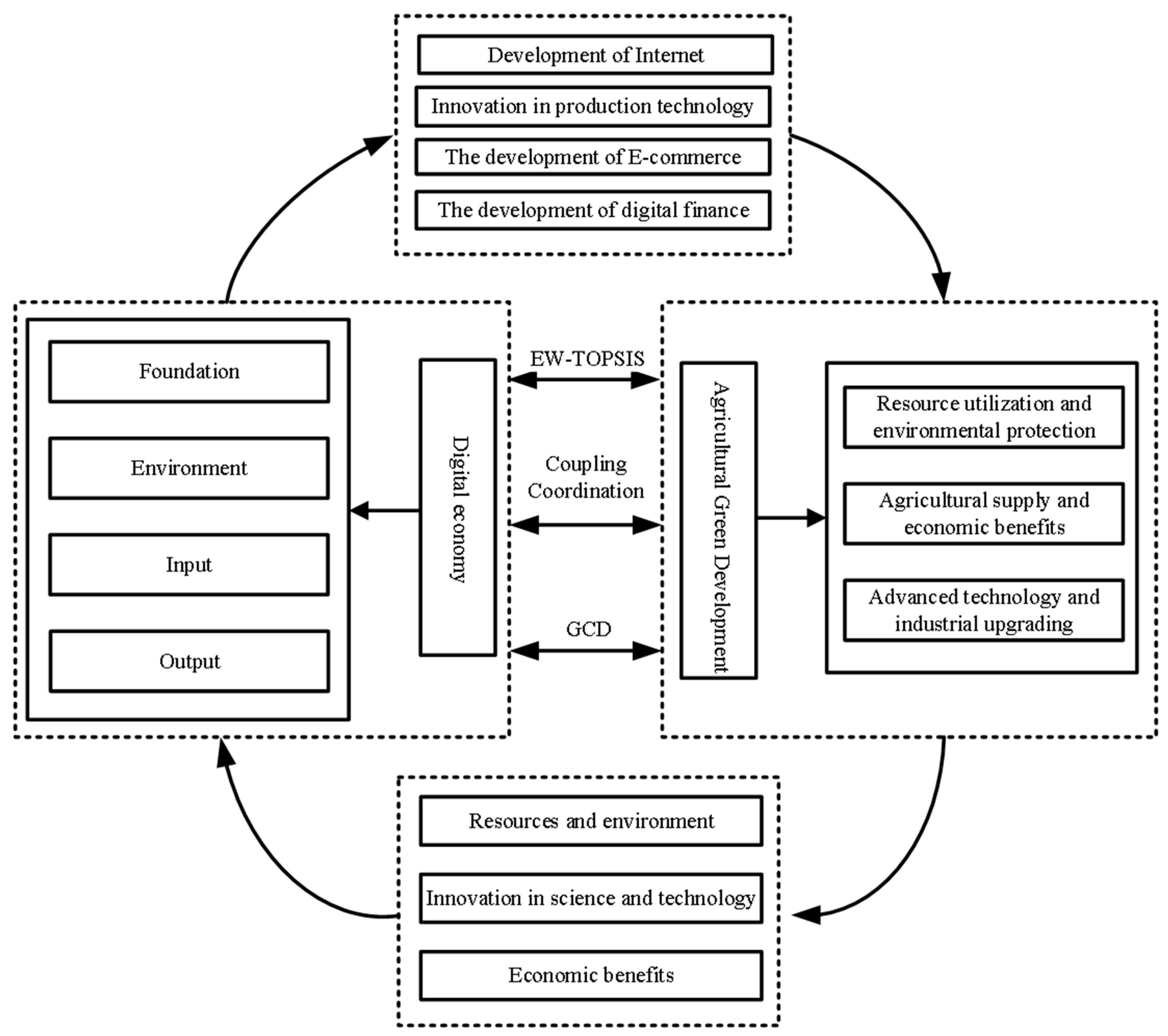
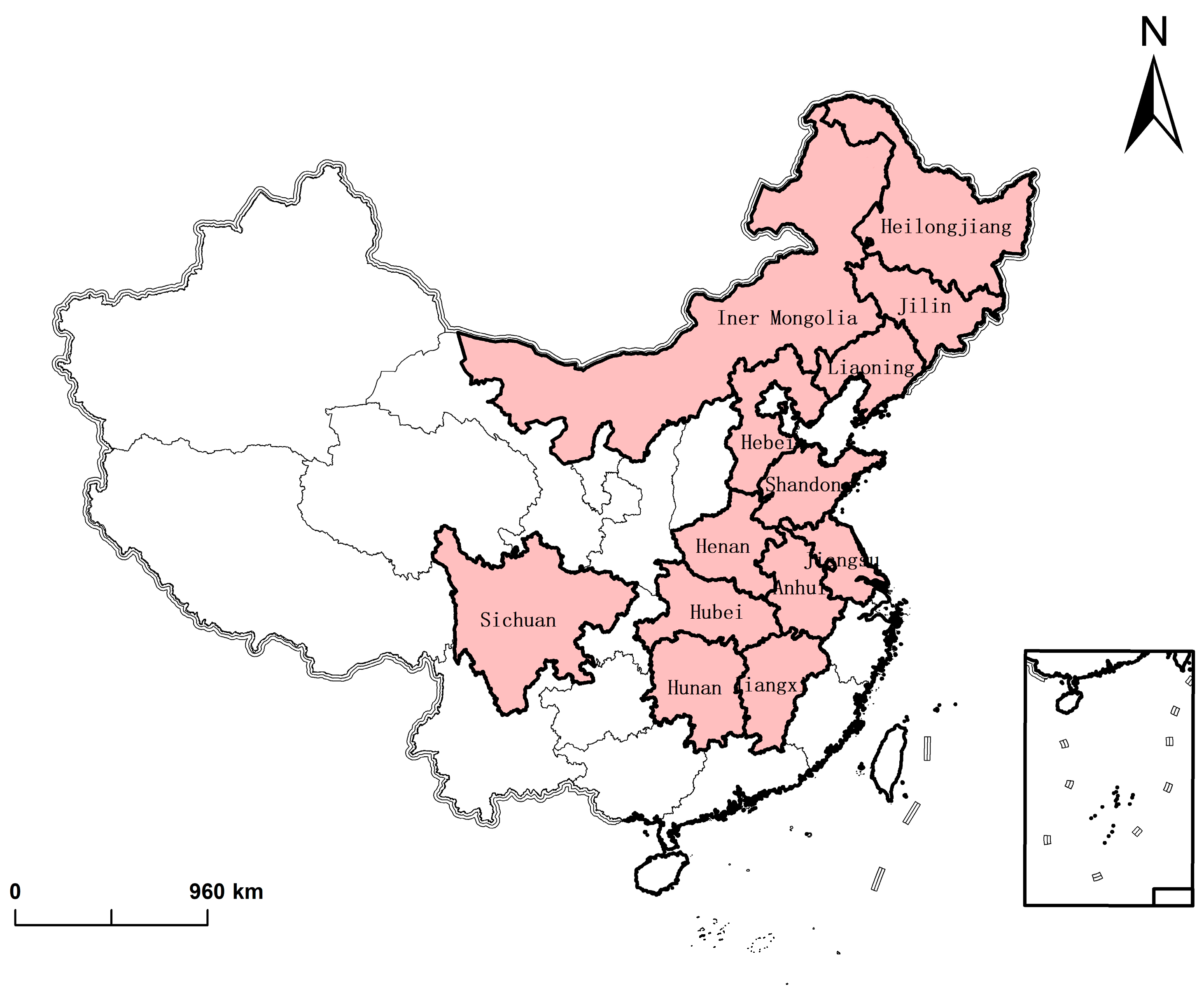
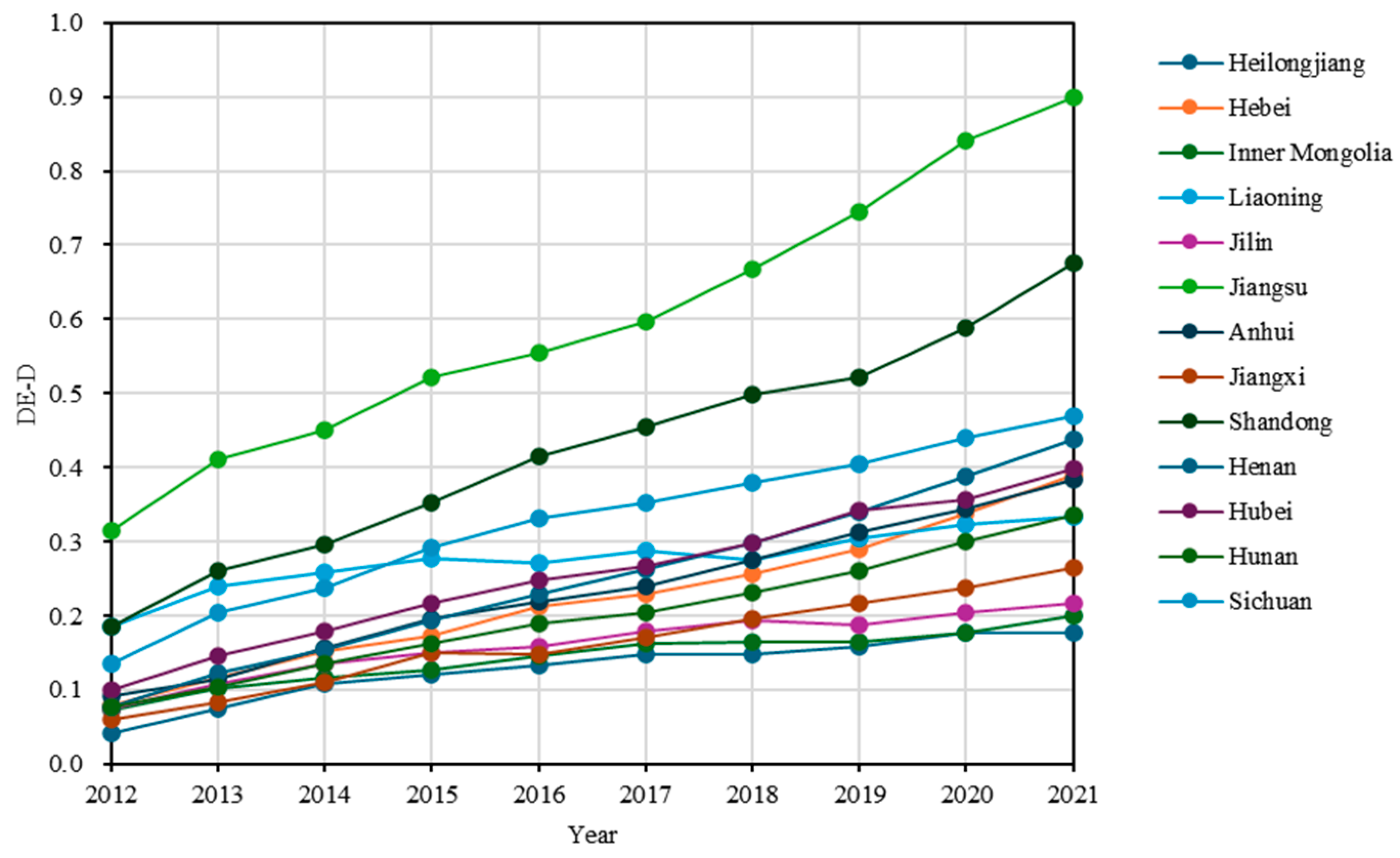
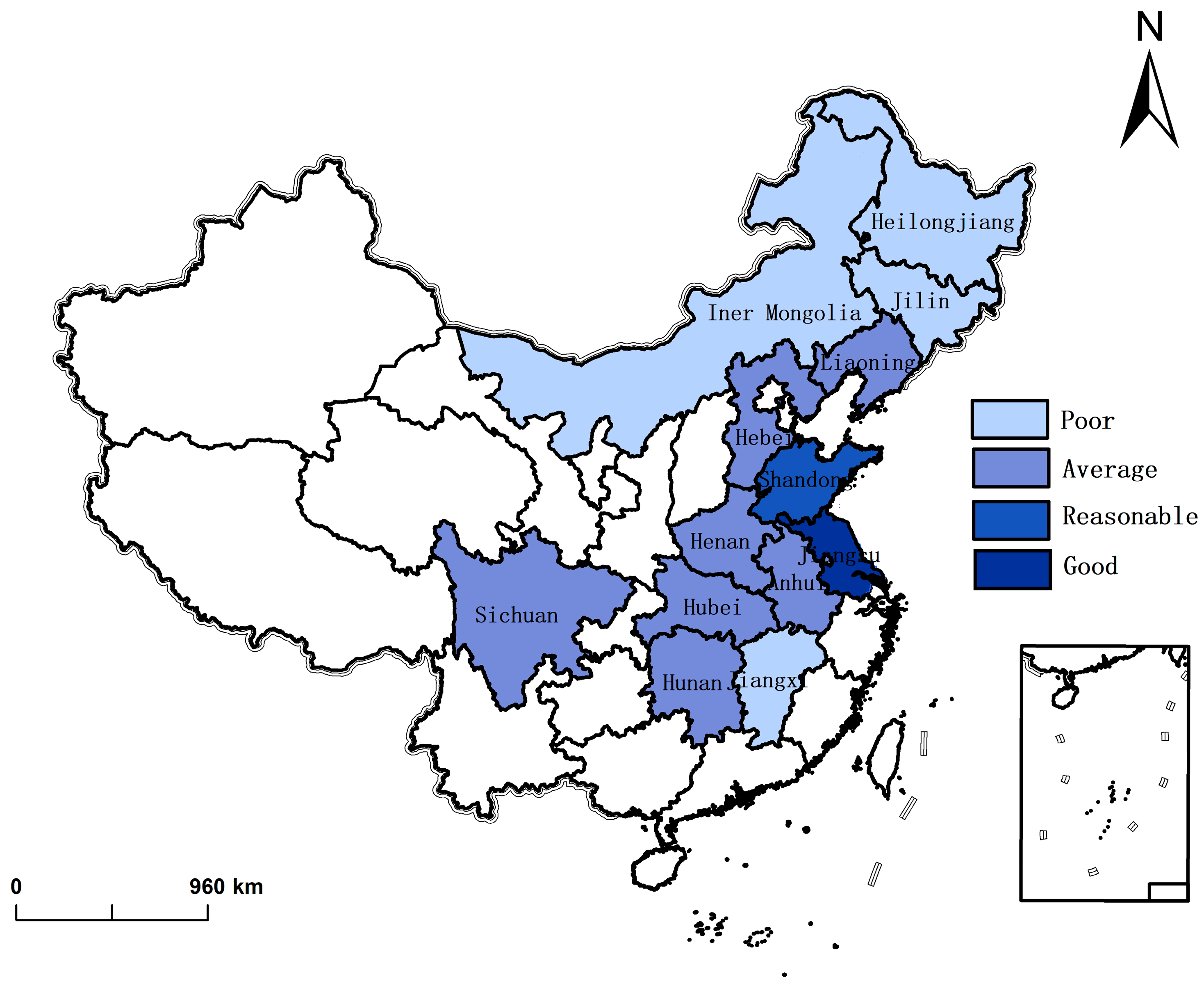
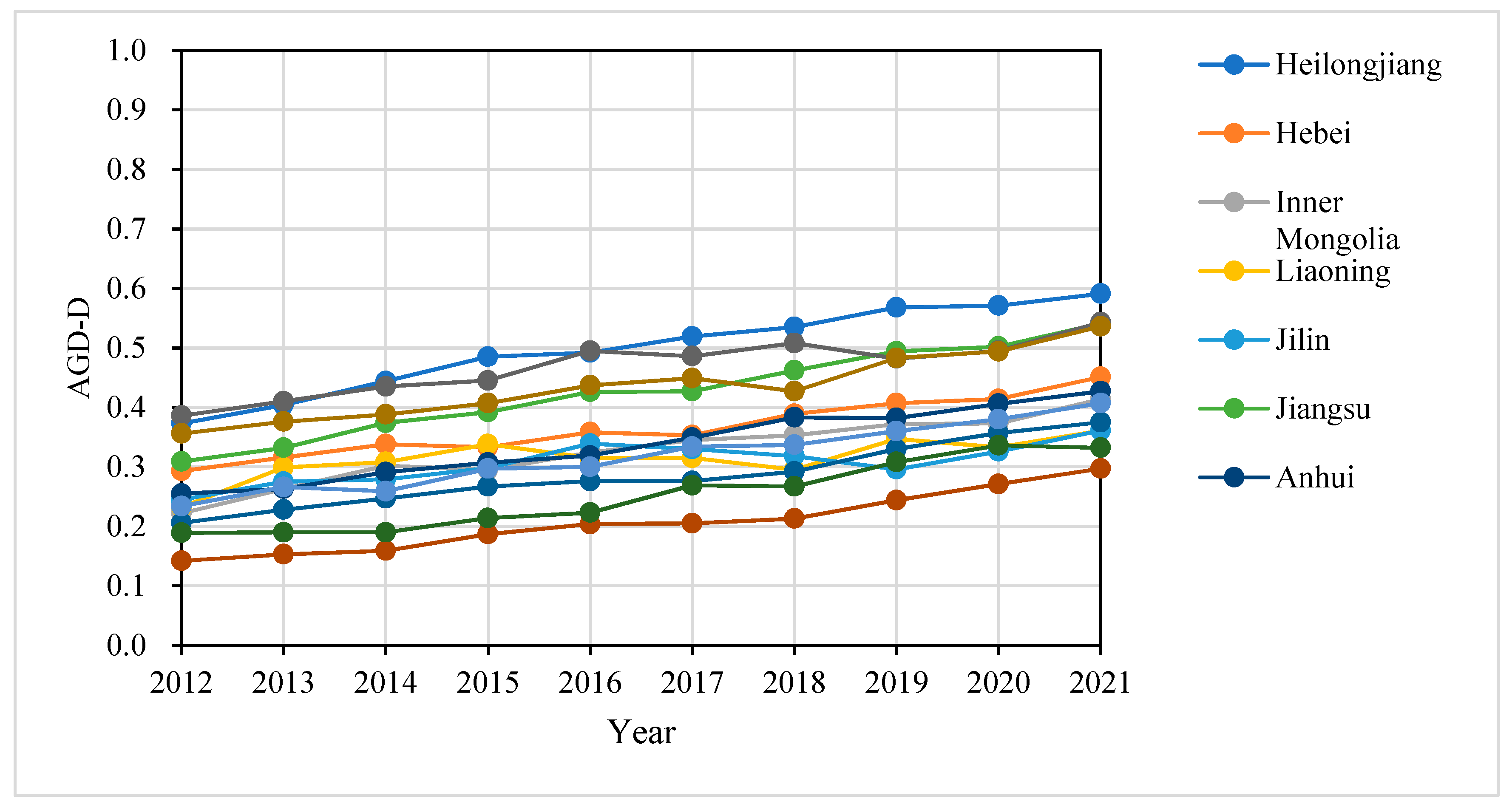
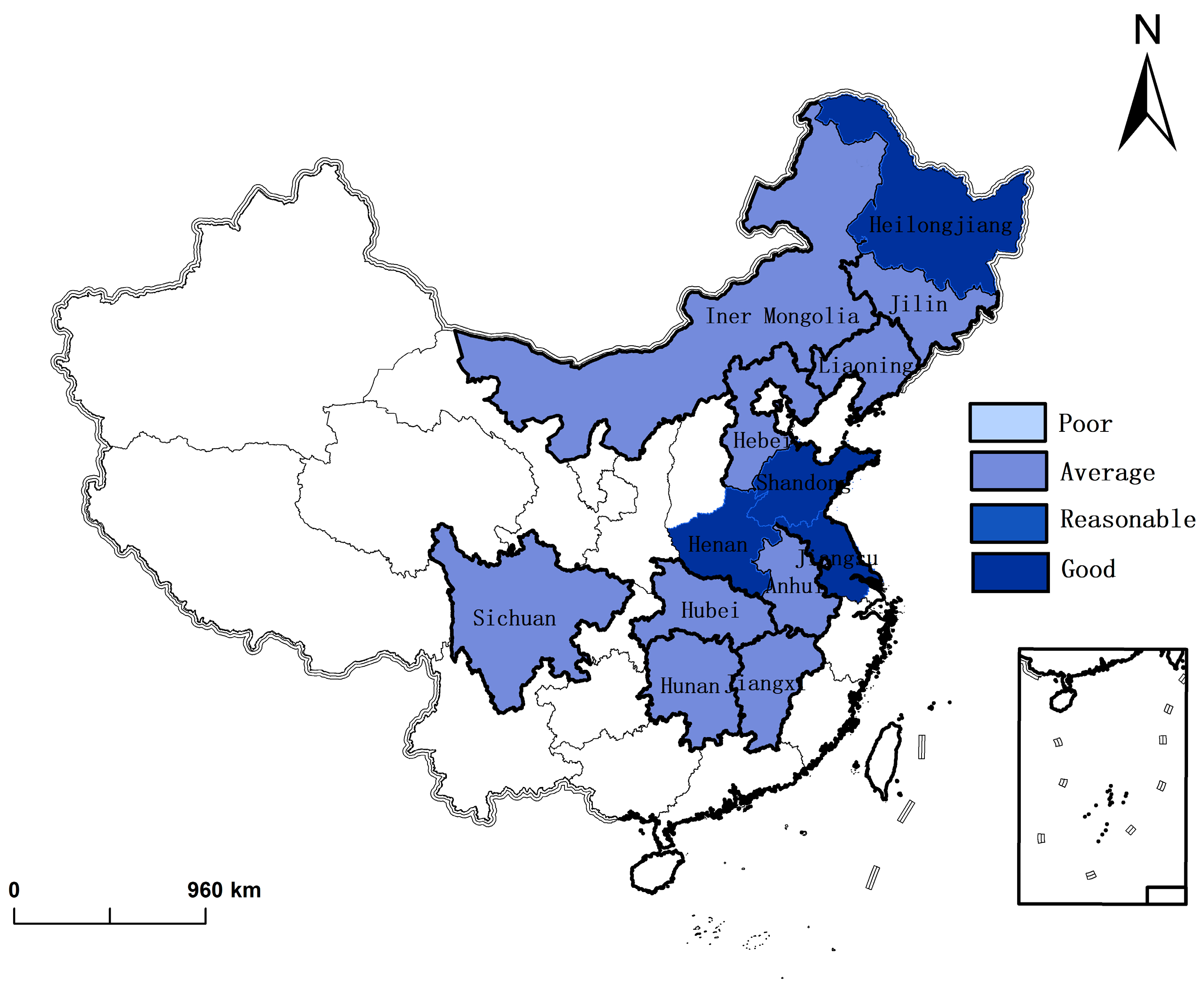



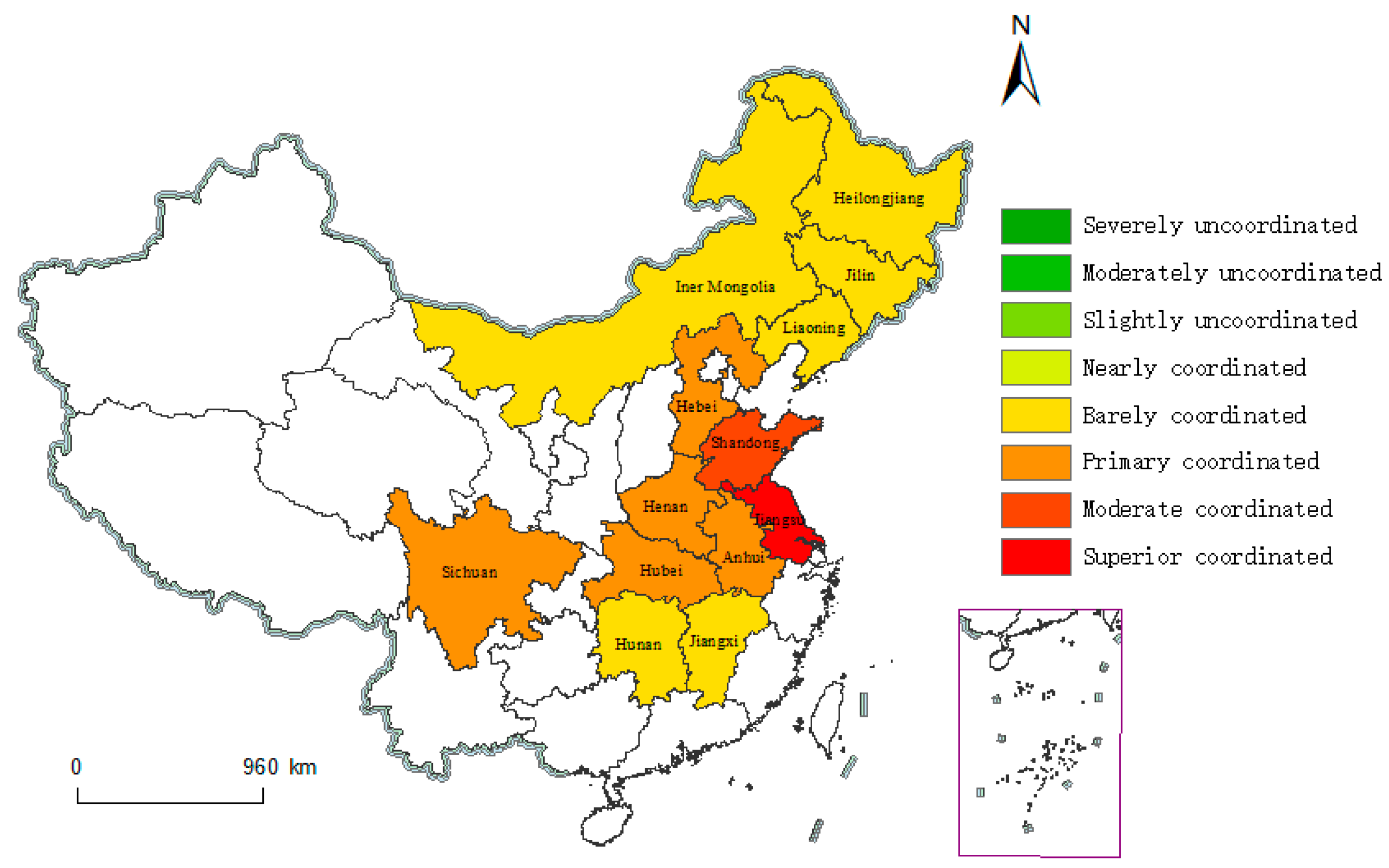
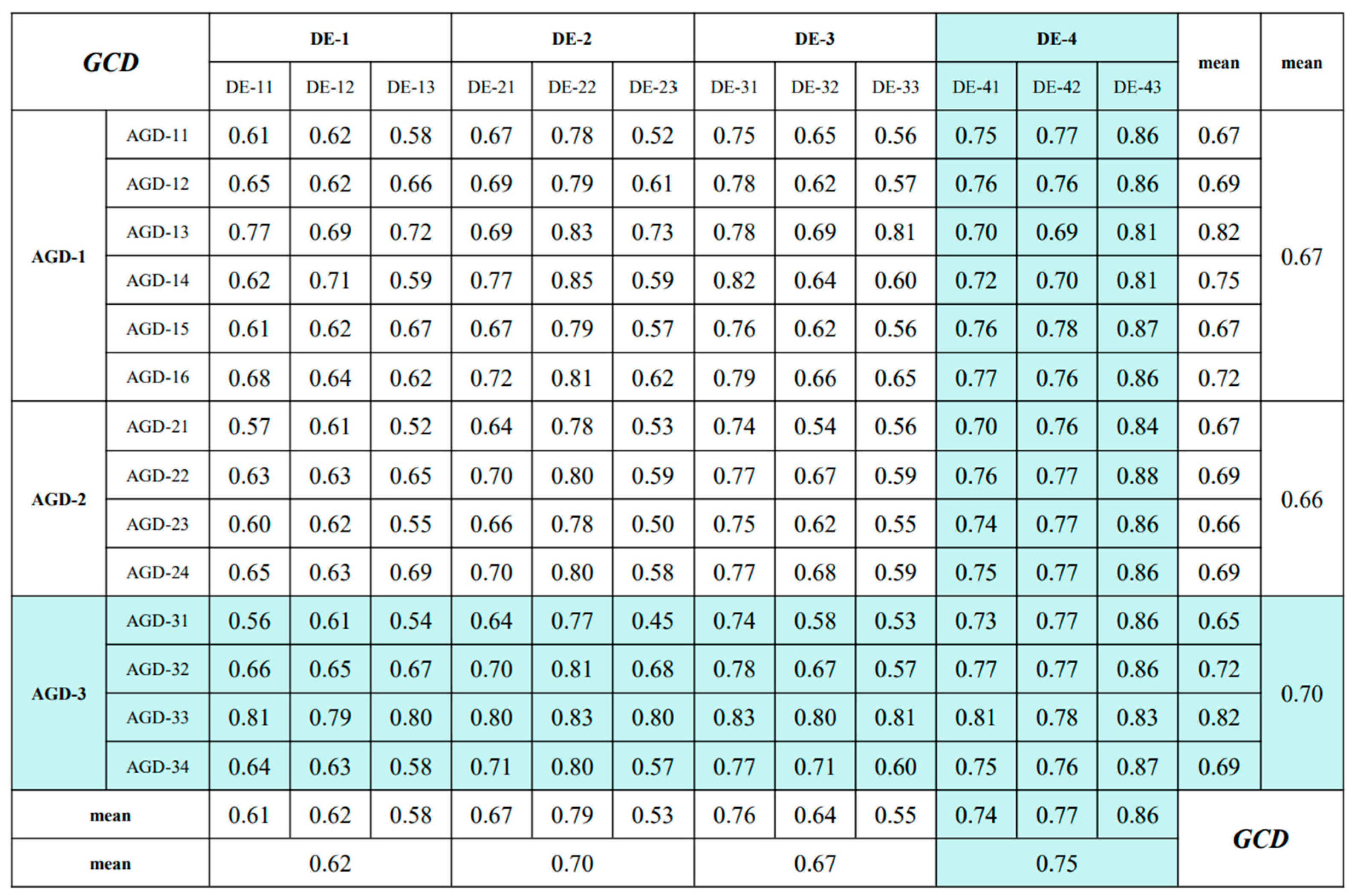
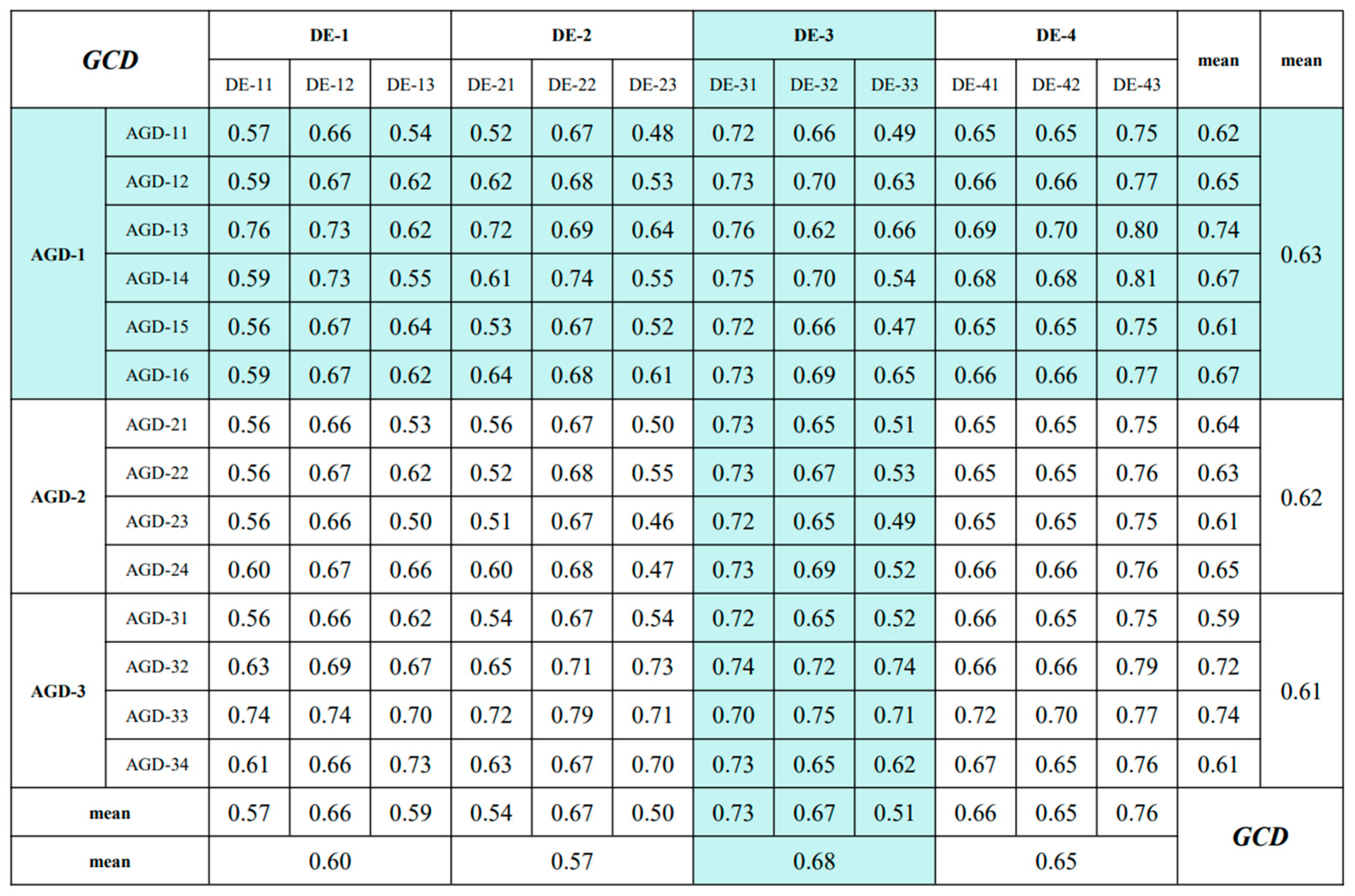
| System | Indicator | Variables | Type |
|---|---|---|---|
| Digital economy (DE) | Foundation (DE-1) | Number of broadband access users (ten thousand households) (DE-11) | + |
| Mobile phone base station density (1/km2) (DE-12) | + | ||
| Mobile phones per 100 people (DE-13) | + | ||
| Environment (DE-2) | Proportion of e-commerce transaction activities of enterprises (DE-21) | + | |
| Number of postal and express parcels (ten thousand pieces) (DE-22) | + | ||
| The Digital Financial Inclusion Index (DE-23) | + | ||
| Input (DE-3) | R&D expenditure of industrial enterprises above the designated size (DE-31) | + | |
| Number of employees in the information service industry (ten thousand people) (DE-32) | + | ||
| The number of websites per 100 enterprises (DE-33) | + | ||
| Output (DE-4) | Enterprise e-commerce transaction volume (RMB 100 million yuan) (DE-41) | + | |
| Revenue from software and information technology services as a proportion of GDP (DE-42) | + | ||
| Number of invention patent applications (granted) (DE-43) | + | ||
| Agricultural Green Development (AGD) | Resource utilization and environmental protection (AGD-1) | Total sown area of crops (thousand hectares) (AGD-11) | + |
| The proportion of the effective irrigated area (AGD-12) | + | ||
| Amount of agricultural plastic film used (tons)/total sown area of crops (thousand hectares) (AGD-13) | − | ||
| The amount of chemical fertilizer and pesticide used per unit sown area (AGD-14) | − | ||
| Utilization rate of livestock and poultry manure (AGD-15) | + | ||
| Investment in environmental pollution control (100 million yuan) (AGD-16) | + | ||
| Agricultural supply and economic benefits (AGD-2) | There are several professional cooperatives per 10,000 people in rural areas (AGD-21) | + | |
| Total value of farm output (AGD-22) | + | ||
| Total grain output (AGD-23) | + | ||
| The per capita disposable income ratio of rural and urban residents (AGD-24) | + | ||
| Advanced technology and industrial upgrading (AGD-3) | That year, the new green, organic food certification and geographical indication of agricultural products registration number (AGD-31) | + | |
| Development of agricultural products processing industry (proportion) (AGD-32) | + | ||
| The proportion of facility agriculture (AGD-33) | + | ||
| Number of environmental and agrometeorological observation stations (AGD-34) | + |
| Grade | Value |
|---|---|
| Excellent | (0.8–1) |
| Good | (0.6–0.8) |
| Reasonable | (0.4–0.6) |
| Average | (0.2–0.4) |
| Poor | (0–0.2) |
| Grade | Value | Grade | Value |
|---|---|---|---|
| Superiorly coordinated | (0.8, 1) | Nearly coordinated | (0.4, 0.5) |
| Slightly uncoordinated | (0.3, 0.4) | ||
| Moderately coordinated | (0.7, 0.8) | Moderately uncoordinated | (0.2, 0.3) |
| Primarily coordinated | (0.6, 0.7) | Severely uncoordinated | (0, 0.2) |
| Barely coordinated | (0.5, 0.6) |
| 2012 | 2013 | 2014 | 2015 | 2016 | 2017 | 2018 | 2019 | 2020 | 2021 | Mean | |
|---|---|---|---|---|---|---|---|---|---|---|---|
| Heilongjiang | 0.041 | 0.076 | 0.108 | 0.122 | 0.134 | 0.149 | 0.149 | 0.159 | 0.178 | 0.178 | 0.129 |
| Hebei | 0.079 | 0.116 | 0.153 | 0.173 | 0.213 | 0.230 | 0.257 | 0.290 | 0.339 | 0.391 | 0.224 |
| Iner Mongolia | 0.073 | 0.102 | 0.116 | 0.128 | 0.146 | 0.162 | 0.165 | 0.165 | 0.177 | 0.200 | 0.143 |
| Liaoning | 0.185 | 0.239 | 0.259 | 0.277 | 0.271 | 0.288 | 0.275 | 0.305 | 0.324 | 0.334 | 0.276 |
| Jilin | 0.076 | 0.109 | 0.135 | 0.151 | 0.159 | 0.180 | 0.195 | 0.188 | 0.205 | 0.218 | 0.162 |
| Jiangsu | 0.316 | 0.412 | 0.451 | 0.522 | 0.555 | 0.596 | 0.667 | 0.745 | 0.841 | 0.899 | 0.600 |
| Anhui | 0.092 | 0.114 | 0.156 | 0.197 | 0.219 | 0.239 | 0.275 | 0.312 | 0.344 | 0.384 | 0.233 |
| Jiangxi | 0.061 | 0.083 | 0.111 | 0.151 | 0.148 | 0.172 | 0.197 | 0.216 | 0.238 | 0.265 | 0.164 |
| Shandong | 0.186 | 0.261 | 0.296 | 0.352 | 0.416 | 0.455 | 0.498 | 0.521 | 0.588 | 0.675 | 0.425 |
| Henan | 0.077 | 0.123 | 0.154 | 0.195 | 0.230 | 0.263 | 0.298 | 0.341 | 0.389 | 0.439 | 0.251 |
| Hubei | 0.100 | 0.146 | 0.179 | 0.216 | 0.249 | 0.268 | 0.298 | 0.342 | 0.357 | 0.399 | 0.255 |
| Hunan | 0.077 | 0.105 | 0.135 | 0.162 | 0.189 | 0.205 | 0.232 | 0.261 | 0.300 | 0.335 | 0200 |
| Sichuan | 0.136 | 0.204 | 0.237 | 0.292 | 0.331 | 0.353 | 0.380 | 0.405 | 0.440 | 0.470 | 0.325 |
| 2012 | 2013 | 2014 | 2015 | 2016 | 2017 | 2018 | 2019 | 2020 | 2021 | Mean | |
|---|---|---|---|---|---|---|---|---|---|---|---|
| Heilongjiang | 0.373 | 0.404 | 0.444 | 0.485 | 0.492 | 0.519 | 0.535 | 0.568 | 0.571 | 0.591 | 0.499 |
| Hebei | 0.293 | 0.316 | 0.338 | 0.333 | 0.358 | 0.353 | 0.389 | 0.407 | 0.414 | 0.451 | 0.365 |
| Inner Mongolia | 0.222 | 0.263 | 0.302 | 0.295 | 0.324 | 0.345 | 0.353 | 0.372 | 0.373 | 0.414 | 0.326 |
| Liaoning | 0.232 | 0.299 | 0.308 | 0.338 | 0.315 | 0.315 | 0.295 | 0.347 | 0.333 | 0.361 | 0.314 |
| Jilin | 0.245 | 0.275 | 0.279 | 0.298 | 0.339 | 0.330 | 0.318 | 0.296 | 0.326 | 0.361 | 0.307 |
| Jiangsu | 0.309 | 0.332 | 0.374 | 0.392 | 0.426 | 0.427 | 0.462 | 0.494 | 0.502 | 0.541 | 0.426 |
| Anhui | 0.255 | 0.263 | 0.291 | 0.307 | 0.319 | 0.349 | 0.383 | 0.382 | 0.406 | 0.427 | 0.338 |
| Jiangxi | 0.142 | 0.153 | 0.159 | 0.187 | 0.204 | 0.205 | 0.213 | 0.244 | 0.271 | 0.297 | 0.208 |
| Shandong | 0.386 | 0.410 | 0.435 | 0.445 | 0.495 | 0.486 | 0.508 | 0.482 | 0.495 | 0.543 | 0.469 |
| Henan | 0.356 | 0.376 | 0.388 | 0.407 | 0.437 | 0.449 | 0.427 | 0.483 | 0.494 | 0.536 | 0.435 |
| Hubei | 0.206 | 0.228 | 0.247 | 0.267 | 0.276 | 0.276 | 0.292 | 0.330 | 0.357 | 0.375 | 0.285 |
| Hunan | 0.189 | 0.190 | 0.190 | 0.214 | 0.223 | 0.269 | 0.267 | 0.308 | 0.336 | 0.332 | 0.252 |
| Sichuan | 0.234 | 0.266 | 0.259 | 0.297 | 0.300 | 0.334 | 0.337 | 0.360 | 0.380 | 0.407 | 0.317 |
Disclaimer/Publisher’s Note: The statements, opinions and data contained in all publications are solely those of the individual author(s) and contributor(s) and not of MDPI and/or the editor(s). MDPI and/or the editor(s) disclaim responsibility for any injury to people or property resulting from any ideas, methods, instructions or products referred to in the content. |
© 2024 by the authors. Licensee MDPI, Basel, Switzerland. This article is an open access article distributed under the terms and conditions of the Creative Commons Attribution (CC BY) license (https://creativecommons.org/licenses/by/4.0/).
Share and Cite
Yang, H.; Xu, X. Coupling and Coordination Analysis of Digital Economy and Green Agricultural Development: Evidence from Major Grain Producing Areas in China. Sustainability 2024, 16, 4533. https://doi.org/10.3390/su16114533
Yang H, Xu X. Coupling and Coordination Analysis of Digital Economy and Green Agricultural Development: Evidence from Major Grain Producing Areas in China. Sustainability. 2024; 16(11):4533. https://doi.org/10.3390/su16114533
Chicago/Turabian StyleYang, Hui, and Xiangda Xu. 2024. "Coupling and Coordination Analysis of Digital Economy and Green Agricultural Development: Evidence from Major Grain Producing Areas in China" Sustainability 16, no. 11: 4533. https://doi.org/10.3390/su16114533
APA StyleYang, H., & Xu, X. (2024). Coupling and Coordination Analysis of Digital Economy and Green Agricultural Development: Evidence from Major Grain Producing Areas in China. Sustainability, 16(11), 4533. https://doi.org/10.3390/su16114533






